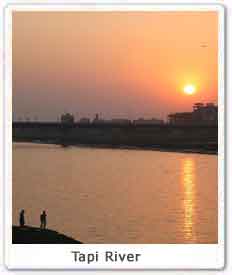Tapi river is one of the major rivers in India. The total length of the Tapi river is approximately around 724 km. It flows in the central part of India. The river originates from the Betul district of Madhya Pradesh in the Satpura range at an elevation of 752 meter above the sea level. The states through which the Tapi river flows include Maharashtra, Gujrat and Madhya Pradesh. Apart from the Narmada river, Tapi is the only river which flows in the westward direction and merges into the Arabian Sea. The Tapi basin extends to the total area of 65, 145 sq km, which is approximately 2.0% of the total geographical area of India. The main tributaries of the Tapi river are Purna, The Girna, The Panjhra, The Vaghur, the Bori and the Aner.
 History
of Tapi River :
History
of Tapi River : In the earlier times Tapi river at Surat was used as the major ports for the purpose of exports of goods and also as an important stopover destination for Muslim pilgrimage called Haj to Mecca.
Other Names of the Tapi River :
Tapati, Tapti, Tapee, Taapi are the other names used for the Tapi river in India.
Religious Significance :
According to the legends, Tapi river also known as Tapti is the daughter of Surya (the Sun God). Some says that Surya created the Tapi river in order to save himself from his own intense heat. The river finds mention in the great Indian epic Mahabharata, according to which Tapti had married Sanvaran, a legendary hero of the moon dynasty. Tapti and Sanvaran also had the son called Kuru. It was on his name only the Kuru dynasty started. Tapi is considered as the Goddess among the Hindus and is worshiped among them.
Around Tapi River :
Tapi river is been supporting the large number of population especially the indigenous people such as Dhodia, and Bhils who are heavily dependent on it. The soil around the Tapi river is good for agriculture. The rural and tribal population around the Tapi river grow large number of chief crops around it and sell it in the market to earn their livelihood. The water of the Tapi river is widely used for the irrigation purpose. Tapi river is the home to the natural habitats of many wild animals including tigers, sloth bear, lions, snakes and many more.






